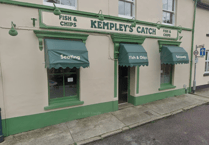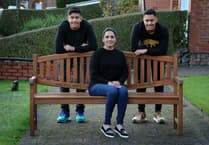LEWTRENCHARD is an area of countryside that brings out the romantic ideals in all of us — the historic church and manor and the woodland valley make everyone who visits stop and think.
The estate was once home to prolific Victorian author and parson Sabine Baring-Gould, known worldwide as the composer of the hymn Onward Christian Soldiers.
But the reason for my visit was to take in the Forgotten Garden — once Sabine’s pride and joy.
Set in the valley called the Glen, a short stream rises some 200 yards to the north and flows under the road into the garden of the Lewtrenchard Manor Hotel (formerly Lew House), before falling into the Quarry Lake to the south.
Sabine inherited the land from his father and from 1881 to 1924 was parson of the church as well as a squire of Lewtrenchard. It was believed that he created a typical Edwardian woodland garden in the Glen in the coming years as a suitable setting for a holy well and as a peaceful place for his wife Grace to enjoy due to her crippling arthritis, to encourage her to take exercise as well as benefiting from the properties of the holy water.
The Holy Well is possibly the most significant feature in the Glen.
Church records reveal that it was restored in 1830 to provide water for the church font. However, the building was knocked down and buried in 1871 during tree felling in the Glen. One of Sabine’s tasks was to restore and re-dedicate the Holy Well which he completed in 1913.
The start of World War One in 1914 saw the young men of the village head out to war, resulting in a heavy strain on Sabine to keep up with maintaining the gardens at Lewtrenchard. Grace’s health then deteriorated and she died in 1916. Sabine was left heartbroken and his own health declined. He died in 1924, shortly before his 90th birthday. The couple had 14 children, ten girls and four boys, who all survived the war.
Four years after Sabine’s death, his eldest son Edward and daughter-in-law Marian, inherited the land. The garden by now was overgrown and ‘forgotten’ and the Holy Well was known as the ‘wishing well’. Marian decided that she wanted to move the structure built by Sabine for the well to form a feature in her new terrace rose garden in front of Lew House — the woodland garden and the Holy Well were then effectively lost and forgotten for nearly a century.
It was around the year 2006, at a meeting of the local history group Lewdown Past, that a few members were intrigued over the location of the Holy Well and what had happened to the monument.
In 2007 they came across their first clue — an old map from 1884 which mentioned the Holy Well (pictured below). One of Sabine’s descendents found an old picture which had been taken by Sabine’s grandson in 1914 and passed onto the Lewdown Past group (see picture on opposite page).
This led a few historians to a location close to the east bank of the stream, which happened to be the only place in the wood where the background matched the background of the photograph.
‘In the stream stuck an old bit of pipe,’ said Ron Wawman, a member of The Friends of the Forgotten Garden.
‘Brian Wilkinson dug it up to see where it went and found the overflow pipe, plinth and inside was the slate lined basin. It’s the feature of the garden — a great find.
‘We cleaned it up and we had it re-dedicated in 2013 — it’s now been re-dedicated three times in its history.’
This early research by history enthusiasts led to the formation of The Friends in 2007 for the purpose of researching and restoring the lost woodland features for the benefit of the local community.
The aim of the group was to research, restore and maintain the Forgotten Garden, together with its associated buildings — pig pen and ‘Lime Kiln’ — and features, as closely as possible to how they might have been during the late 19th and early 20th centuries. Their aim was also to preserve and advance the heritage of Sabine Baring-Gould.
The Friends recently held a car rally at Lewtrenchard to help raise money for the roof appeal for the Lime Kiln situated within the Forgotten Garden.
It is referred to locally as both the Lime Kiln and the Ice House on the map (pictured below).
Due to the garden and associated buildings being left to ruin, trees have been allowed to grow out of control which has led to the demise of the buildings and the roofs.
Chairman of the friends’ group Graham Yeo said: ‘Once it has been restored this will be a visitor centre to explain what we have done and what happened here.
‘We don’t know what exactly it was used for previously but it had to have a function.
‘We have been given the slates by Markstone Granite and we are hoping the roof will be put on by a local contractor. Costs have been kept down by the community coming together.’
Ron added: ‘We have leased the garden from the estate for a peppercorn rate. Patron of the group is Merriol Almond, the great, great granddaughter of Sabine, who is keen to let the group look after the garden.’
The garden was opened to the public in 2011 and is open all day every day for the use by the community.




